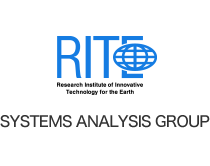Global Warming Research & Analyses
Analysis of energy mix and GHG emission projection in Japan
April, 2015
Analysis of energy mix and GHG emission projection in Japan
Government of Japan is currently discussing about Japan's energy mix and INDC (GHG emission reduction target). We have made an analysis regarding this discussion by using energy assessment model “DNE21+” and energy-economic model "DEARS" both originated by RITE, under a consistent condition with the macro frame used for considering energy mix by the government.
Specific scenarios for the analysis have been assumed under several energy mix in the year of 2030, in which base-load power source (nuclear, coal, hydro and geothermal) ratios are 40%, 50% and 60%, and renewable source ratios are 15%, 20%, 25% and 30%. In addition to them, we assumed 2 scenarios with different intensity of CO2 emission reductions ("New Policies scenario" and "450 scenario" of IEA World Energy Outlook 2014) in order to evaluate energy saving conditions in final energy demand or CO2 emission reduction countermeasures. Under these scenarios we have made analysis to estimate energy mix, primary energy supply, energy system costs, impacts on GDP and electricity charge forecast as well.
Base-load power ratio in 2013 was about 40%, a significant decrease from 60% at the time before the Great East Japan Earthquake. Our result shows that if base-load power ratio in 2030 increase up to 50% (assumed RE ratio of 25%) from 40% (RE ratio of 30%), energy system costs will likely to decrease by ¥1.4 trillion/year. Furthermore, base-load power ratio of 60% (RE ratio of 20%) would decrease energy system costs by ¥2.4 trillion/year (in case of CO2 emission reduction intensity would be equivalent to WEO New Policies Scenario). GDP is estimated to increase, compared to the as-is case, by ¥2.6 trillion/year and by ¥3.5 trillion when base-load power ratio is 50% and 60%, respectively. Likewise, GHG emission in 2030 will likely to decrease by 10% compared to 2005, under condition of base-load power ratio with 60% and nuclear power with 20% , as well as under stringent energy-saving policy in final energy demand. In order to bring this reduction to 15%, nuclear power ratio is required to be 25%.
See files below for more detail.
Energy is a foundation of industries, thus decision-making in energy policy would affect economy and GHG emissions on a long-term basis. To comprehend interaction among economic impact, emission reduction and energy mix based on a highly probable, objective and consistent analysis is crucial for decision-making. (released on March 31, 2015)
- Analysis of energy mix and GHG emission projection in Japan(PDF file xxxKB)
In the analysis above, average costs of power generation under several scenarios with different energy mix were estimated in the year 2030. Supplementary analysis of time-series has been done to see a transition of average cost of power generation.
(released on April 14, 2015)
In the analysis released on March 31, we have evaluated emissions reduction forecast in Japan under GHG reduction countermeasures with a carbon price level of New Policies Scenario and 450 scenario of IEA WEO2014. In this supplementary analysis we have analyzed global emission reduction forecast by nations, assuming that major countries would take countermeasures up to different level of carbon prices. This would serve as a reference information when comparing emission reduction effort by each country. (released on April 14, 2015)




